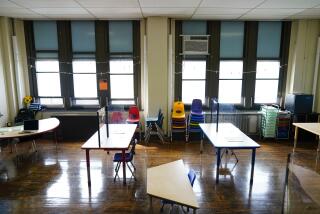Private Tutor Newest of Status Symbols : Education: Parents seek extra help to give their children an edge.
- Share via
Even though 9-year-old Barry Dreiband already speaks four languages and earns good grades, his mother drives him after school to a private tutor in an Alexandria, Va., shopping center. There, in an office next to Domino’s Pizza, she plops down $35 an hour for extra reading instruction.
In Bethesda, Md., Meghan Moscoti, 15, and her tutor hold math sessions at the dining-room table. She, too, gets good marks but scores even better with the one-on-one attention that guides her through trouble spots in algebra.
“I like it because I can say, ‘Wait. I don’t get it,’ ” she said. “At school you have one chance, and if you don’t get it, you don’t get it.”
Parents in affluent parts of the country are turning to tutors to help their children. Some prefer the increasingly visible networks of teachers making house calls. Others drive to a new academic innovation: shopping-mall tutors.
For as long as parents have had children and money, they have been paying for extra school help. But what is happening now is that relatively expensive private tutoring is becoming more mainstream.
The reasons run from parental guilt--not enough time or desire to step through the proofs of the binomial theorem--to a perception that even the best students can use more instruction than they get in class.
While tutoring was most often reserved for students cramming for college-entrance exams or struggling not to flunk a course, students seeking tutors these days frequently are high achievers. These students begin getting tutored as early as the first grade, though the majority are in junior and senior high school.
“It used to be that having a tutor had a stigma to it, but now it’s seen as being lucky if you can get extra help for your kid,” said Tiffany Smith, co-owner of Potomac Tutors, which opened eight months ago in the Potomac Village, Md., shopping center. “Now kids brag about ‘my tutor.’ ”
At suburban soccer and lacrosse matches, parents can be heard trading notes on tutors as if they were talking about summer camps, supermarket specials or discount designer shops. Most schools, public and private, try to schedule time for teachers to meet with students after school. But students say it’s often hard to match their free time with their teachers’.
Roberta Bren Tutorial Service, based in Montgomery County, Md., has a stable of 50 tutors who fan out to some of the Washington, D.C., region’s wealthier addresses. Her rates run $35 to $50 an hour.
The phenomenon is the same in other affluent areas. Nationally, there are more than 500 Sylvan Learning Centers, offices resembling classrooms where certified teachers work with groups of two or three students. A competing tutorial chain, Huntington Learning Centers, is growing too, with 100 offices selling by-the-hour reading, writing and arithmetic.
In Westchester County outside New York City, honor-roll students chat about the personalized attention and convenience of tutors. After all, they say, it’s not like they can stay after school--there is band, yearbook and gymnastics.
“I don’t have the time after school,” said Deborah Schoeneman, a junior at Mamaroneck (N.Y.) High School, who like many other students has extracurricular activities after her last class.
Besides, Schoeneman said, all of her close friends have tutors.
For some, tutors are almost a status symbol, for others a good idea. Some public-school advocates sigh, saying tutors are just another sign of a disturbing gap between the educational opportunities of the poor and the wealthy.
But Barry Dreiband’s mother, Mahla, said she sees the issue of paying for extra academic help as related more to a family’s priorities than its income. Dreiband, who works as a government computer program analyst, pays $35 an hour for her son’s tutoring because she wants to give him an edge. She thinks American schools try to cram too many subjects into too short a school day and year.
More to Read
Sign up for Essential California
The most important California stories and recommendations in your inbox every morning.
You may occasionally receive promotional content from the Los Angeles Times.













